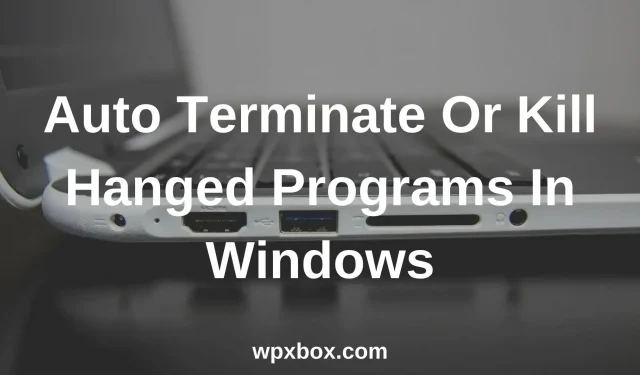How to Automatically Kill Unresponsive Programs in Windows 11/10

The program in Windows often freezes. Sometimes this is due to a lack of resources. Sometimes it just is and becomes unavailable. Although you can kill them using the task manager, the task manager is also not responding properly. In this post, we will look at several ways to kill unresponsive programs in Windows.
How to Automatically Kill Unresponsive Programs in Windows
You can use these methods to kill or terminate programs in Windows.
- Registry Editor
- Task list
- Close the program with the task list shortcut
Now let’s briefly talk about these methods one by one and use an administrator account to follow them.
1 Set timeout in registry editor
- Use Win + R to open the Run window. Type Regedit and press the Enter key to open the Registry Editor.
- Navigate to the following registry path:
HKEY_CURRENT_USER\Control Panel\Desktop - Right click the empty space in the right pane and then create these lines if they are not available or change the value. Be sure to select Select New > String Value.
- WaitToKillAppTimeout = 2000
- AutoEndTasks = 1
- HungAppTimeout = 1000
- LowLevelHooksTimeout = 1000
- Enter the string name as above. Double click on the row, enter a value and click OK.
After that, Windows will automatically shut down the program without a long wait.
Typically, Windows waits about 5 seconds for background services to complete their work and release resources. However, if you think it takes more time, you can set the registry value by following the method below:
- Open Registry Editor and navigate to the following path:
HKEY_LOCAL_MACHINE\SYSTEM\CurrentControlSet\Control - Locate and double-click the line WaitToKillServiceTimeout in the right pane.
- You can then change the value. Since the time is taken in milliseconds, be sure to change it accordingly.
- Click OK and exit.
Now to help you learn more about registry strings. Here’s what they mean:
- AutoEndTask: Instead of showing you an app close button, this will automatically close any app. This will crash your application if it gets stuck. You will not be able to save your work.
- WaitToKillAppTimeout : This works when Windows is shutting down . This gives you enough time to save your work, the default time is 20 seconds.
- HungAppTimeout : A program or application that has been unresponsive for more than five seconds. In this case, the program will be stopped. However, you can increase the value to make the program work again. This way you can save your work.
2 Taskkill command line utility
Taskkill is another option. It allows you to terminate programs and processes using a graphical interface. It can also be used to kill programs from the command line, and here’s how you can do it.
- Open a Run prompt with Win + R. Then type wt and press shift + enter to launch Windows Terminal.
- To open the full list of programs, type a list of tasks, and then press Enter. You will see a list of all programs and services running on your computer.
- Write down the name of the program you want to kill and run the following command. Change the program name if necessary:
taskkill /IM programmname.exe. The program will end immediately.
- It is possible to forcibly kill a program if Windows doesn’t. To do this, you need to run
taskkill /F /IM iexplore.exethe command. - In addition, you can force close multiple processes at once. To do this, you need to add the PID numbers of all methods one by one with spaces in between:
Taskkill /PID 1412 1279 1398 /F.
3 Create a shortcut to kill unresponsive programs
The task list method is cumbersome and requires you to repeatedly open the command prompt to terminate programs. Instead, you can create a shortcut. To do this, follow these steps:
- Right-click on the desktop and select New > Shortcut.
- A pop-up window will appear, type taskkill /f /fi “status eq not response”here and click next.
- Then give the shortcut a name and click Done to create a desktop shortcut.
- Now every time the program does not respond. Launch a desktop shortcut to close the program immediately.
So, that was the answer to your question about ways to automatically kill unresponsive programs in Windows. They work on all versions of Windows, including Windows 11 and Windows 10.
Leave a Reply